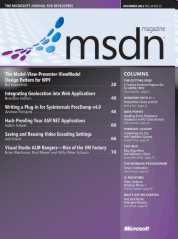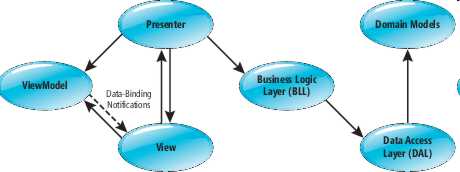| MSDN Magazine December 2011 |
| Written by Mike James | |||
| Tuesday, 06 December 2011 | |||
|
The December MSDN Magazine is well and truly available and it's a very mixed and slightly disappointing issue.
The top feature is most likely MVPVM Design Pattern. You may know the MVC pattern but the MVVM and MVPVM patterns are more closely associated with Microsoft and WPF/Silverlight systems. In this case the article is based on the Prism project, which aims to explain and catalog the sorts of approaches to using WPF that are well architected. MVPVM is the name the author gives to one of the more sophisticated Prism patterns. The article goes through the stages of explaining MVC, why MVVM is a better fit for WPF, and why MVPVM is even better. The arguments are interesting but the article is light on practical examples, mainly due to its length. In this case more would be better. It also doesn't read as an authoritative account, something you might expect from MSDN Magazine. As a lead article it is interesting, but not of the quality you might expect.
Another architecture/management article is: Visual Studio ALM Rangers -- Rise of the VM Factory and it is full of lots of things I was previously unaware of. The "Rangers" is a group dedicated to promoting collaboration among the VS product group, Microsoft Services and MVPs - so that's a fairly narrow and internal sort of mission then? The VM Factory is a facility that turns out virtual machines - which is an odd thing to do using licensed software. The article is written in that abstract style that makes it more difficult than it need be to follow what is going on. A few simple sentences at the start might have given the reader a better idea of what the objective is before they launched into the detail. Sentences like: The purpose of the VM Factory is to develop prescriptive guidance around virtualization, particularly for Visual Studio, Team Foundation Server (TFS), Lab Management and associated prerequisites. do no one any favors. Hack-Proofing Your ASP.NET Applications is a much more down to earth article - as you might expect. However, it starts out from the very basics with a discussion of SQL injection. Can there be a developer on the planet with any knowledge of security issues who doesn't know about SQL injection? This objection aside, it is a good basic introduction with .NET examples of what it is and how to avoid it. However, it does raise the question of why ASP.NET does have built in classes to allow the sanitization of SQL strings. From SQL injection the article moves on to parameter tampering and then it closes. This is a welcome but very narrow view of ASP.NET security dealing with the two best known, and not particularly ASP.NET specific, problems. Sysinternals ProcDump v4.0 explains how ProcDump v4.0 works and how to write a plug in for it withing Sysinternals. Clearly aimed at a niche audience but if you are among that audience worth reading. Integrating Geolocation into Web Applications is a look at how to use HTML5 geolocation API - this is hardly a cutting edge topic. The article simply goes over the standard JavaScript needed, with an emphasis on IE 9. It also goes into how geolocation works and how to use Modernizr to make up for the lack of gelocation support in earlier browsers. It is difficult to know what an introductory article on non-Microsoft technologies is doing in MSDN MSDN Magazine - even if it is a good introduction for the complete beginner. Equally out of place, to my mind, is Saving and Reusing Settings for Video Encoding. This goes over video basics, then it introduces Video for Windows, VfW. If nothing else, this article suggests that VfW might be still an ongoing technology for Microsoft, but there is very little otherwise to indicate that it is. Whenever I use VfW I always feel that an apology for not using more modern technology is in order - such as DirectX, WDM etc. If you lookup VfW on the Microsoft site you will find that, while it is still documented, you are pointed in the direction of DirectX and it has the feel of a dead technology - even if it is still used quite a lot in the real world. The main part of the article describes how to allow the user to select a codec and how to persist the choice, which isn't really core VfW and, if you are not already using it, you probably won't be making much of the advice. So at the end of the day is VfW still a usable technology? The regular columns provide an equally wide range of topics. Among them Dino Esposito gives us a context-sensitive progress bar for APS.NET, but MVC not classic. Kenny Kerr wraps up his in-depth look at the thread pool with timers and I/O. Julia Lerman explains OData, WCF and the Entity Framework and Joseph Fultz explains the final part of his inventory project in Azure. If you have a computer science-ish mind, then Tabu Algorithms and Maximum Clique by Dr McCaffrey will be of interest - at the end he suggests some areas where research is needed. This is probably the best article in the entire magazine - but then I like this sort of algorithmic problem. Another really good article is Ted Neward's introduction to using the Sprache parser. Given how many people are interested in DSLs know how to use a simple parser is a worthwhile investment. Finally we have the ever practical Charles Petzold telling it like it is in the world of WP7 video and creating a video kaleidoscope along the way - fun.
Overall a disappointing month for MSDN Magazine which seems to have lost its way - let's hope it's only temporary because there are lots of real issues in the Microsoft development world that we need to talk about that are currently being ignored by Microsoft and MSDN Magazine.
More Information
To be informed about new articles on I Programmer, subscribe to the RSS feed, follow us on Google+, Twitter or Facebook or sign up for our weekly newsletter.
|
|||
| Last Updated ( Tuesday, 06 December 2011 ) |




